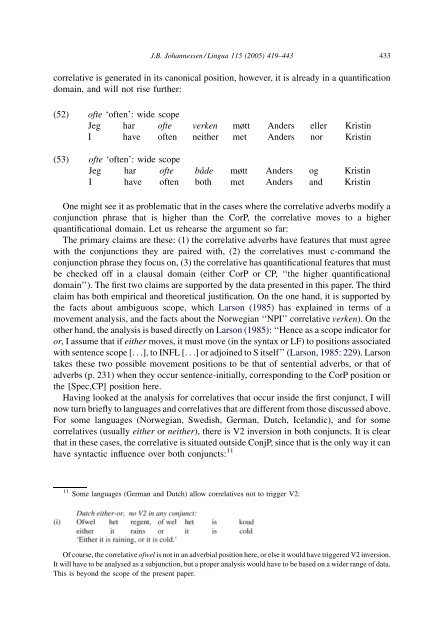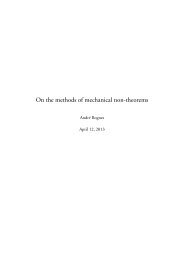The syntax of correlative adverbs
The syntax of correlative adverbs
The syntax of correlative adverbs
You also want an ePaper? Increase the reach of your titles
YUMPU automatically turns print PDFs into web optimized ePapers that Google loves.
J.B. Johannessen / Lingua 115 (2005) 419–443 433<br />
<strong>correlative</strong> is generated in its canonical position, however, it is already in a quantification<br />
domain, and will not rise further:<br />
(52) <strong>of</strong>te ‘<strong>of</strong>ten’: wide scope<br />
Jeg har <strong>of</strong>te verken møtt Anders eller Kristin<br />
I have <strong>of</strong>ten neither met Anders nor Kristin<br />
(53) <strong>of</strong>te ‘<strong>of</strong>ten’: wide scope<br />
Jeg har <strong>of</strong>te både møtt Anders og Kristin<br />
I have <strong>of</strong>ten both met Anders and Kristin<br />
One might see it as problematic that in the cases where the <strong>correlative</strong> <strong>adverbs</strong> modify a<br />
conjunction phrase that is higher than the CorP, the <strong>correlative</strong> moves to a higher<br />
quantificational domain. Let us rehearse the argument so far:<br />
<strong>The</strong> primary claims are these: (1) the <strong>correlative</strong> <strong>adverbs</strong> have features that must agree<br />
with the conjunctions they are paired with, (2) the <strong>correlative</strong>s must c-command the<br />
conjunction phrase they focus on, (3) the <strong>correlative</strong> has quantificational features that must<br />
be checked <strong>of</strong>f in a clausal domain (either CorP or CP, ‘‘the higher quantificational<br />
domain’’). <strong>The</strong> first two claims are supported by the data presented in this paper. <strong>The</strong> third<br />
claim has both empirical and theoretical justification. On the one hand, it is supported by<br />
the facts about ambiguous scope, which Larson (1985) has explained in terms <strong>of</strong> a<br />
movement analysis, and the facts about the Norwegian ‘‘NPI’’ <strong>correlative</strong> verken). On the<br />
other hand, the analysis is based directly on Larson (1985): ‘‘Hence as a scope indicator for<br />
or, I assume that if either moves, it must move (in the <strong>syntax</strong> or LF) to positions associated<br />
with sentence scope [...], to INFL [...] or adjoined to S itself’’ (Larson, 1985: 229). Larson<br />
takes these two possible movement positions to be that <strong>of</strong> sentential <strong>adverbs</strong>, or that <strong>of</strong><br />
<strong>adverbs</strong> (p. 231) when they occur sentence-initially, corresponding to the CorP position or<br />
the [Spec,CP] position here.<br />
Having looked at the analysis for <strong>correlative</strong>s that occur inside the first conjunct, I will<br />
now turn briefly to languages and <strong>correlative</strong>s that are different from those discussed above.<br />
For some languages (Norwegian, Swedish, German, Dutch, Icelandic), and for some<br />
<strong>correlative</strong>s (usually either or neither), there is V2 inversion in both conjuncts. It is clear<br />
that in these cases, the <strong>correlative</strong> is situated outside ConjP, since that is the only way it can<br />
have syntactic influence over both conjuncts: 11<br />
11 Some languages (German and Dutch) allow <strong>correlative</strong>s not to trigger V2:<br />
Of course, the <strong>correlative</strong> <strong>of</strong>wel is not in an adverbial position here, or else it would have triggered V2 inversion.<br />
It will have to be analysed as a subjunction, but a proper analysis would have to be based on a wider range <strong>of</strong> data.<br />
This is beyond the scope <strong>of</strong> the present paper.
















